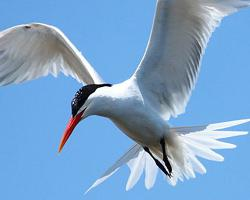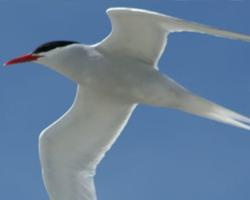
Starea de conservare
| Amenințat |
Descrierea animalului
The Inca tern, scientifically known as Larosterna inca, is a highly distinctive and visually striking seabird native to the Pacific coast of South America. With its sleek, predominantly slate-grey plumage, punctuated by a starkly contrasting bright red-orange bill and feet, this species is immediately recognizable. One of its most remarkable features is the white mustache on either side of its head, which stands out against its dark feathers. This mustache is not just a key identification mark but also believed to be a sign of vitality and thus plays a role in mate selection.The Inca tern is a medium-sized bird, measuring about 40 centimeters in length and weighing approximately 200 grams. Its body is streamlined for efficient flight, with long, pointed wings and a deeply forked tail that it uses adeptly both in the air and while skimming over the ocean's surface. Its flight is buoyant and agile, allowing it to perform acrobatic maneuvers as it hunts for fish and small marine invertebrates.
Found exclusively along the Humboldt Current, which flows along the west coast of South America from northern Peru to central Chile, the Inca tern inhabits coastal regions, islands, and islets. It prefers areas with rocky shores or cliffs where it can nest. The bird's breeding sites are often located near abundant marine life, especially during the breeding season when its dietary needs increase.
The Inca tern is a social bird, typically found in colonies that can number in the hundreds. These colonies are noisy, with birds frequently calling to one another in a variety of harsh, raspy tones. Breeding pairs are monogamous, often returning to the same nesting sites year after year. Nests are usually built in crevices or cavities in the cliffs, where females lay one to three eggs. Both parents share in the incubation duties and in feeding the chicks once they hatch.
The diet of the Inca tern primarily consists of small fish, squid, and crustaceans, which they catch by skillfully diving into the water or picking from the ocean's surface while in flight. Their hunting technique is a spectacular sight, as they hover momentarily above the water before plunging in to capture their prey.
Conservation-wise, the Inca tern is considered Near Threatened due to a combination of factors including habitat loss, human disturbance, and possibly climate change affecting ocean currents and thus the abundance of their prey. Efforts are being made to protect their breeding sites and to monitor population numbers closely.
In addition to its ecological role, the Inca tern holds cultural significance for the indigenous peoples of the region, featuring in local art and mythology. Its unique appearance and charismatic behavior also make it a favorite among birdwatchers and wildlife photographers, who are often captivated by its striking looks and dynamic aerial displays.
In summary, the Inca tern is a remarkable bird, both for its distinctive appearance and its fascinating behaviors. Its presence along the South American coast highlights the rich biodiversity of the region and underscores the importance of preserving its natural habitats for future generations.
Animale similare
Fotografii noi cu animale
Top 10 animale
- Dolphin gull (Leucophaeus scoresbii)
- Diana monkey (Cercopithecus diana)
- Moustached guenon (Cercopithecus cephus)
- Galápagos tortoise (Geochelone nigra complex)
- Stone loach (Barbatula barbatula)
- Greek tortoise (Testudo graeca)
- Japanese macaque (Macaca fuscata)
- Russian tortoise (Testudo horsfieldii)
- Common flying dragon (Draco volans)
- Galápagos penguin (Spheniscus mendiculus)


